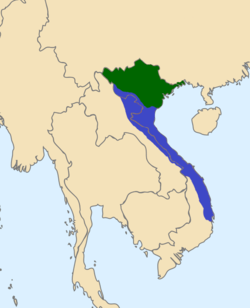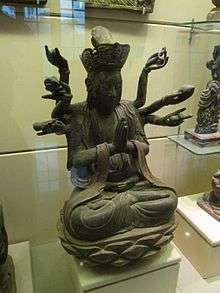Mạc dynasty
The Mạc dynasty (Vietnamese: Nhà Mạc / Mạc triều / Nhà Bắc Mạc; Hán Nôm: 家莫 / 莫朝 / 家北莫), as known as Northern Mạc or House of Mạc ruled the whole of Đại Việt between 1527 and 1533 and the northern part of the country from 1533 until 1592, when they lost control over the capital Đông Kinh for the last time in their wars against the Lê dynasty.[lower-alpha 1] Subsequent members of the Mạc dynasty ruled over the province of Cao Bằng (with the direct support of the Ming and Qing dynasties) until 1677.
Mạc Triều / Bắc Mạc (莫朝 / 北莫) Đại Việt Quốc (大越國) | |||||||||
|---|---|---|---|---|---|---|---|---|---|
| 1527–1677 | |||||||||
 | |||||||||
| Status | Chinese tributary[1] (Ming 1540–1644) (Southern Ming 1644–1661) (Qing 1644–1673) | ||||||||
| Capital | Đông Kinh (1527–1592) Cao Bằng (1592–1677) | ||||||||
| Common languages | Vietnamese | ||||||||
| Religion | Neo-Confucianism, Buddhism, Taoism, Roman Catholicism | ||||||||
| Government | Monarchy | ||||||||
| Emperor | |||||||||
• 1527–1541 | Mạc Đăng Dung (first) | ||||||||
• 1638–1677 | Mạc Kính Vũ (last) | ||||||||
| History | |||||||||
• Established | 1527 | ||||||||
• Disestablished | 1677 | ||||||||
| Currency | Văn | ||||||||
| |||||||||
Part of a series on the |
||||||||||||||||||||||||
|---|---|---|---|---|---|---|---|---|---|---|---|---|---|---|---|---|---|---|---|---|---|---|---|---|
| History of Vietnam | ||||||||||||||||||||||||
 | ||||||||||||||||||||||||
|
||||||||||||||||||||||||
|
Dominated
|
||||||||||||||||||||||||
|
||||||||||||||||||||||||
|
||||||||||||||||||||||||
|
||||||||||||||||||||||||
| Timeline | ||||||||||||||||||||||||
|
| ||||||||||||||||||||||||
Mạc Đăng Dung
The founder of the Mạc dynasty was a man who was related to a famous Trần dynasty Confucian scholar named Mạc Đĩnh Chi. The Ming's ethnic Vietnamese collaborators included Mac Thuy whose grandfather was Mạc Đĩnh Chi who was a direct ancestor of Mạc Đăng Dung.[2][3] Unlike his ancestor, Mạc Đăng Dung chose to enter the military and ascended the ranks to become the senior general in the Vietnamese army. Later he seized power in a coup d'état and ruled Vietnam from 1527 till his death in 1541. Officially he resigned his position as Emperor in favor of his son but the reality was, he continued to rule.[4]
Mạc Đăng Dung, famed for his strength and cunning, got his start as a bodyguard for Lê Uy Mục, the unpopular Lê Emperor, around 1506. Over time, despite the deaths of several emperors, Mạc Đăng Dung increased his power and gained many supporters. However, he also gained the enmity of other rivals for power.
Around 1520, a civil war started. This war would last, with occasional breaks, for the next 150 years. Apparently fearing the growing ambition of Mạc Đăng Dung, the young Emperor, Lê Chiêu Tông, fled to the south. A revolt started with the Trịnh and the Nguyễn families claiming to support the Emperor against the power of Mạc Đăng Dung. Mạc Đăng Dung responded by proclaiming that the Emperor's younger brother, Prince Xuan, was now the true Emperor and installed as Emperor under the name Lê Cung Hoàng. The revolt was ended, temporarily, when Mạc Đăng Dung's forces captured and executed Lê Chiêu Tông along with the leaders of the revolt.
In 1527 Mạc Đăng Dung removed the figurehead Emperor he had installed earlier and proclaimed himself as the new Emperor under the title Minh Đức. This usurpation of the throne from the rightful Lê Emperors was not well received by the officials in the government. Some were killed, some committed suicide, some fled to the south to join a new revolt by the Trịnh and the Nguyễn against the Mạc Emperors.
A new revolt began, and both sides tried to pull in allies, mainly the Ming dynasty but also from King Phothisarat I of Lan Xang (modern-day Laos). Mạc Đăng Dung, through submissive diplomacy and massive bribes, convinced the Ming not to attack in 1528. He then abdicated his position as Emperor in favor of his son, Mạc Đăng Doanh a year later. However, this was done purely to solidify his son's claim to rule after he was gone. In reality Mạc Đăng Dung continued to rule with the title of Senior Emperor (Viet: Thái thượng hoàng).
Mạc Đăng Dung's return

The revolt in the south gathered strength and over the next three years all the provinces south of the Red River were captured by the Nguyễn and Trịnh armies. In 1533 the figurehead Lê Emperor, Lê Trang Tông, was officially crowned at the newly recaptured western capital.
At this point, Mạc Đăng Doanh died and his father reclaimed the throne. The Ming Chinese threatened Mạc Đăng Dung with an invasion of 110,000 men ready to invade Vietnam from Guangxi in 1540. Mac succumbed and caved in to Chinese pressure and accepted the bitter demands the Chinese made, including crawling barefoot in front of the Chinese, giving up land to China, downgrading the status of his polity from a country to a chieftaincy and giving up official documents like tax registers to the Ming.[5][6] The Ming official position was that the Mạc should rule over the northern half of Vietnam, while the Lê should rule over the southern half (in other words, below the Red River). Then the Ming returned home. The Nguyễn and the Trịnh refused to accept this division of the country and the war continued.
In 1541 Mạc Đăng Dung died and was succeeded by his grandson Mạc Phúc Hải.
1541–92: Lê–Mạc wars
Mạc Phúc Hải ruled only for six years, during which he was defeated by the Trịnh army and lost more territories. He was succeeded by Mạc Phúc Nguyên (1545–61) who had to fight a war with his brother Trung.
Mạc Mậu Hợp ruled from 1561 to 1592. He was the last significant Mạc ruler. In 1572 the capital was captured by the Trịnh army but then he recaptured it a year later. Then, in 1592, Trịnh Tùng unleashed a massive invasion of the north and conquered Hanoi along with the rest of the northern provinces. Mạc Mậu Hợp was captured during the retreat and was cut to pieces over three days. The Mạc had lost control over most of Vietnam, only retaining areas around Cao Bằng Province under the formal protection of the Ming army.
1592–1677: Northern rule and decline
In 1592, the new Mạc leader was Mạc Kinh Chi. He managed to assemble a large army which defeated the army of Trịnh Tùng but a year later, he and his army were wiped out by a new Trịnh army under Trịnh Tùng. Mạc Kinh Cung ruled for more than twenty years (1593–1616). Based out of Van Ninh (Quảng Ninh Province) the Mạc army staged many attacks against the Trịnh. The Trịnh requested and received aid from the Nguyễn and the joint army (with Nguyễn Hoàng) defeated the Mạc.
In 1598 yet another official Ming commission declared the Mạc to be rulers over Cao Bằng province and so the Mạc rulers stayed in this protected area, occasionally launching raids into Trịnh controlled Vietnam.
After the fall of the Southern Ming, the Qing dynasty became the mediator in the Lê-Mạc conflict while receiving tribute from both sides.[1][7] The Kangxi Emperor attempted to negotiate peace between the two states.[7] After the Lê attacked and gained control of Cao Bằng Province without permission from the Qing, the Kangxi Emperor demanded in 1667 that Lê Chiêu Thống return Cao Bằng Province to the Mạc.[7] In 1673, the Qing had lost interest in mediating the conflict on behalf of the Mạc.[7] In 1677, the Revolt of the Three Feudatories in southern China prompted the Qing to enlist the aid of the Lê, who accused the Mạc of joining the rebels.[7] The Kangxi Emperor and his advisors agreed to arrest Mạc Kính Vũ as he fled into Guangxi, leading to the demise of the Mạc dynasty.[7]
Foreign relations
The Lê dynasty held a tributary relationship with the Ming dynasty in exchange for the recognition and military protection.[8][9][1] As part of their tributary relationship, the Ming to provided external military support to the Lê state against the Mạc beginning in 1537.[1] After the 1540 surrender of the Mạc to the Ming, the Ming court ceremonially revoked the Lê dynasty's status as an independent kingdom and reclassified it as a dutongshisi: a category only slightly higher than a chieftaincy.[1] After 1540, the Ming received tribute from both the Lê dynasty and the Mạc, a state of affairs that continued through the end of the Southern Ming at which point the two sides became tributary states of the Qing dynasty.[1][7][7]
Legacy
While contemporary historians of feudal Le and Nguyen dynasties regarded Mac rulers as downright usurpers, historians after 1945 debate over this controversial dynasty with more favorable and objective viewpoints. Modern researchers recognize that during the reign of Mạc Emperors, women enjoyed much more freedom and privileges than in the previous dynasties. The Mạc court also allowed domestic and foreign trade to flourish, resulting in the rise of Đông Đô and the surrounding areas such as Chu Đậu in Hải Dương province as an important link in the East-West maritime commerce route.
Many notable figures of the Mạc court, such as Prince regent Mạc Kính Điển, general Nguyễn Quyện, general Mạc Ngọc Liễn were praised by both friends and foes for their virtues, talents and exceptional loyalty, which is indeed rarely seen far and wide.
See also
Notes
- Lockhart & Duiker, p. 437.
- Mạc Dynasty:
- Mạc Thái Tổ (Mạc Đăng Dung) (1527–30)
- Mạc Thái Tông (Mạc Đăng Doanh) (1530–40)
- Mạc Hiến Tông (Mạc Phúc Hải) (1540–46)
- Mạc Tuyên Tông (Mạc Phúc Nguyên) (1546–64)
- Mạc Mậu Hợp (Ruler without imperial titles) (1564–92)
Citations
- Baldanza, Kathlene (2014). "Perspectives on the 1540 Mac Surrender to the Ming". Asia Major. 27 (2): 115–146. JSTOR 44740553.
- Taylor, p. 232.
- Lockhart & Duiker, p. 229.
- Hodgkin
- Dardess, p. 5.
- Yamazaki
- Baldanza, Kathlene (2016). Ming China and Vietnam: Negotiating Borders in Early Modern Asia. Cambridge University Press. p. 207. ISBN 9781316531310.
- Le Loi at the Encyclopædia Britannica
- Womack, B. (2012). "Asymmetry and China's Tributary System". The Chinese Journal of International Politics. 5 (1): 37–54. doi:10.1093/cjip/pos003. ISSN 1750-8916.
References
- Dardess, John W. (2012). Ming China, 1368–1644: A Concise History of a Resilient Empire. Rowman & Littlefield. ISBN 978-1442204904.CS1 maint: ref=harv (link)
- Hodgkin, Thomas (1981). Vietnam: The Revolutionary Path. St. Martin's. ISBN 978-0312845889.CS1 maint: ref=harv (link)
- Lockhart, Bruce M.; Duiker, William J. (2010). The A to Z of Vietnam. The A to Z guide series. Lanham, MD: Scarecrow. ISBN 978-0810876460.CS1 maint: ref=harv (link)
- Taylor, K. W. (9 May 2013). A History of the Vietnamese. Cambridge University Press. ISBN 978-0-521-87586-8.
- Yamazaki, Takeshi (2013). "Tongking Gulf under Reconquest? Maritime Interaction Between China and Vietnam Before and After the Diplomatic Crisis in the Sixteenth Century". Crossroads. 8. Retrieved 27 August 2019.